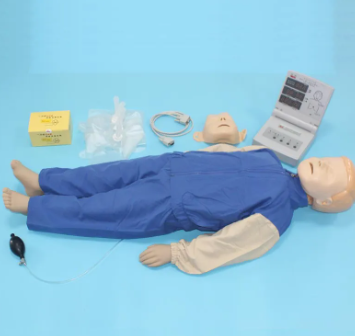

In order to ensure the effectiveness of the training of children's cardiopulmonary resuscitation model, correct operation is essential. Here are some key steps and considerations to help rescuers get the most out of the model for effective training:
...In order to ensure the effectiveness of the training of children's cardiopulmonary resuscitation model, correct operation is essential. Here are some key steps and considerations to help rescuers get the most out of the model for effective training:

First, environmental preparation
Ensure that the training environment is safe from interference and potential hazards.
Prepare the required equipment and materials, such as children's cardiopulmonary resuscitation model, AED (automatic external defibrillator) simulator, mask, respiratory skin bag, etc.
Second, model setting
Check whether the children's cardio-pulse resuscitation model is intact and ensure that the model can simulate the physiological response of children normally.
According to the training requirements, set the initial state of the model, such as heartbeat arrest, respiratory arrest, etc.
3. Operation process
Assess the condition: Check the child's vital signs, including breathing, heartbeat, consciousness, and pupil response. You can judge the consciousness of the child's foot by tapping or flicking, and call for help immediately if there is no response.
Open airway: Place the child flat on the ground with the head to one side. Use your fingers to remove secretions and vomit from your nose and mouth to keep your airways open. Open the airway by raising the head and chin, so that the head is tilted back and the jaw and earlobe are connected perpendicular to the ground.
Artificial respiration: Use a mask or mouth-to-mouth method to perform artificial respiration. Make sure your lips are close to the child's nose and mouth, holding the nose to prevent air leakage. Blow for more than 1 second, blow twice. Observe the child's chest for fluctuation.
External chest compression: the compression site is the middle and lower 1/3 junction of the median sternal line or below the midpoint of the connection between the two nipples. Place your palms on top of each other and press down vertically. The depth of compression is 1/3 of the depth of the child's chest, about 4-5 cm. Press frequency is 100-120 times/min. Allow the chest to bounce back fully after each compression.
Cycle operation: Perform a cycle of chest compressions and artificial respiration in a ratio of 30:2. Consciousness, pulse, and breathing were assessed every 5 cycles or 2 minutes.
4. Precautions
Keep calm during operation to avoid excessive tension and panic.
Strictly follow the operation procedure to ensure that each step is correct.
Pay attention to the response and feedback of the model, and adjust the operation method and force in time.
After the training, summarize the experience and lessons in time, and constantly improve their first-aid ability.